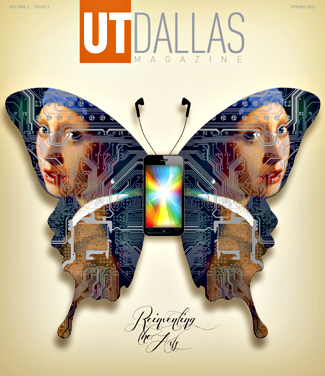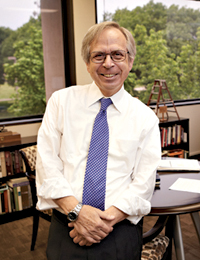
UT Dallas Magazine includes the full version of “Reinventing the Arts.” The magazine is available for viewing online.
The following are excerpts from “Reinventing the Arts,” the cover article in the just-released edition of UT Dallas Magazine. The piece was written by Gaile Robinson, an area art critic and arts writer. The full version of this story and other articles are available in the magazine’s online edition.
What do you get when you put an animator, a physicist and a painter together?
Don’t anticipate a punch line; there isn’t one. Not yet.
“The answer will come in the future,” said Dr. Dennis Kratz, dean of the School of Arts and Humanities, “in a place designed to create pathways among people, projects and ideas.”
As dean, Kratz has developed an interdisciplinary curriculum that fosters collaboration at the intersection of arts and humanities, science and engineering.
“There is a statistical correlation between Nobel Prize winners and art,” Kratz said. “It enables them to see from a different viewpoint.”

“There is a statistical correlation between Nobel Prize winners and art,” said Dean Dennis Kratz.
Kratz’s viewpoint, a broadminded administration, and a creative faculty eager to transform the traditions of a typical liberal arts program, have redefined how the arts and humanities are viewed and taught at UT Dallas.
“This isn’t about putting art in a science-based university. It’s about reconstructing the way we educate people to bring science, art and humanities together,” Kratz said.
“We want to suffuse everything.”
Kratz’s manifest destiny—geographically and cognitively—is recognized by way of the Arts and Technology Program, Texas’s first degree that combines computer science and engineering with arts and humanities.
ATEC is a contemporary hybrid, a joint creation of the Erik Jonsson School of Engineering and Computer Science and the School of Arts and Humanities.
New ATEC Building Demonstrates Commitment
“It’s right on the center of campus. This is prominent real estate. This tells you about the University’s own priorities.” said Dr. Richard Brettell, the Margaret M. McDermott Distinguished Chair of Art and Aesthetic Studies.
The 155,000-square-foot, $60 million project is scheduled for its ribbon cutting in 2013. It will provide 2,150 new classroom seats and 50 offices, as well as a lecture hall that will seat 1,200. The building was designed by Studios Architecture, the same firm that designed the Googleplex, Google’s headquarters in Mountain View, Calif.

Dr. Dave Parry, assistant professor of Arts and Technology and emerging media and communication.
Student Perspectives Broaden
“Humanities students often have no understanding why the Internet is fundamentally different from other forms of communication. The computer science students get it. But the humanities students understand the critical issues and why it matters on a cultural level. When you get them together it’s more productive,” said Dr. David Parry, assistant professor of ATEC and emerging media and communication
Parry believes there is an absolute necessity to be digitally literate. “In the future, the people who have power—power in a good way, power over their own lives—will be digitally literate,” he said. “There will be people who understand how to make, use, manipulate, critique and engage with social media in all its forms and there will be people who will just consume.” Parry sees his job as moving the consumers into the group of producers.
Recent Hires Show Emphasis
Dr. Roger Malina is a physicist, astronomer and executive editor of the Leonardo publications at MIT Press. With dual appointments as a distinguished professor of arts and technology in the School of Arts and Humanities and a professor of physics in the School of Natural Sciences and Mathematics, he focuses on connections among the natural sciences and arts, design and the humanities.
“In my career, I’ve had the scientific strand and the art and technology strand. This is an opportunity to combine both,” Malina said. “There are not many places in the U.S. or internationally that are doing what we’re trying to accomplish here—merge arts and humanities with science and engineering at a deep level and with the resources to support it.”

Dr. Venus Opal Reese, an associate professor of aesthetic studies, teaches and performs.
Freedom for Faculty
In more established institutions of higher learning, Dr. Venus Opal Reese, who teaches everything from identity theory to hip-hop dance, knows that taking her solo performance show on the road would be viewed with disapproval.
“I would have been penalized, not rewarded,” said Reese, associate professor of aesthetic studies. When schools post a job for an artist and a scholar, she said, most want a performer or a scholar to teach traditional theater history.
“When in truth, I don’t teach theater history. I do teach how people themselves perform, in terms of gender, race, sexuality and class. And I am a working performer. Taking this job afforded me the opportunity to be my whole self.”